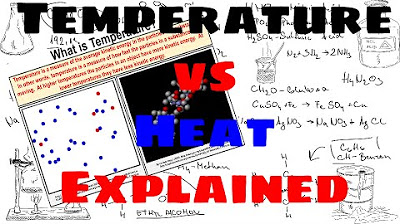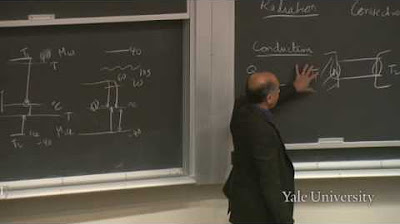Lesson 4 - Temperature in Chemistry
TLDRThe chemistry tutor video script introduces the fundamental concepts of density and temperature, emphasizing the importance of understanding these definitions to excel in chemistry. Temperature is described as a measure of the internal energy of an object, which is directly related to the kinetic energy of the motion of its atoms and molecules. When an object has a higher temperature, its atoms and molecules vibrate more vigorously, leading to a higher energy content. This energy transfer can cause harm, such as burns, when touching a hot object. The video aims to provide a clear definition of temperature and its implications in everyday life and chemistry, making complex concepts more accessible.
Takeaways
- 🔥 **Temperature as Energy Indicator**: Temperature is a measure of the internal energy of an object, with higher temperatures indicating more energy content.
- 🌡️ **Understanding Temperature**: Everyday experiences with hot and cold help us understand temperature, but a scientific definition provides a more precise understanding.
- 🔎 **Temperature and Kinetic Energy**: The temperature of a material is directly related to the kinetic energy of its atoms and molecules, which is the energy of motion.
- 🌟 **Vibration and Temperature**: As temperature increases, the atoms and molecules within a material vibrate more vigorously.
- 🤚 **Consequences of Touching Hot Objects**: Contact with a hot object can transfer energy to the hand, potentially damaging tissues due to the intense motion of the object's particles.
- ⚡ **Energy Transfer**: The energy from a hot object can be transferred to the hand, causing a burn by the rapid motion of particles.
- ❄️ **Extremes of Temperature**: Both extremely hot and cold temperatures can be harmful, demonstrating that temperature is a critical factor in the interaction between objects and living tissue.
- 📈 **Thermometers and Temperature**: A thermometer measures the temperature, which reflects the amount of energy and the intensity of particle motion within a substance.
- 🧠 **Importance of Definitions**: Gaining a solid understanding of fundamental definitions is crucial for grasping more complex concepts in chemistry and other subjects.
- 🌟 **Temperature Scales**: The concept of temperature is quantified through various scales that measure the internal energy of a system.
- 🔬 **Chemistry and Everyday Life**: The understanding of temperature and density has practical implications in everyday life as well as in the field of chemistry.
Q & A
What is the basic concept of temperature?
-Temperature is a measure of the internal energy of a substance, specifically the kinetic energy of motion of the atoms and molecules within that material.
Why does a higher temperature indicate more energy in an object?
-A higher temperature indicates more energy because it means the atoms and molecules within the object are vibrating more vigorously, thus possessing greater kinetic energy.
How does temperature relate to the sensation of hot and cold?
-The sensation of hot and cold is related to temperature because it reflects the amount of energy an object has. Hot objects have a higher temperature and thus more energy, which can cause a burning sensation, while cold objects have less energy and a lower temperature.
Why can extreme temperatures, both hot and cold, cause harm?
-Extreme temperatures can cause harm because they involve a significant transfer of energy. When you touch something very hot, the energy from the object is transferred to your hand, potentially damaging your tissue. Similarly, extremely cold temperatures can cause frostbite due to the rapid loss of heat from the body.
What happens on a microscopic level when you touch a hot object?
-On a microscopic level, touching a hot object causes the energy of motion (kinetic energy) from the object's vibrating atoms and molecules to be transferred to your hand. This energy transfer can disrupt the tissues in your hand, causing a burning sensation.
How does understanding the definition of temperature help in chemistry?
-Understanding the definition of temperature helps in chemistry because it forms the basis for comprehending more complex concepts and reactions. It is a fundamental concept that underpins many chemical processes and can affect reaction rates, phase changes, and other phenomena.
What is the significance of temperature scales in measuring temperature?
-Temperature scales provide a standardized way to measure and compare temperatures. They allow scientists and individuals to communicate about temperature in a consistent and reproducible manner, which is crucial for scientific experiments and everyday applications.
How does the kinetic theory of matter relate to temperature?
-The kinetic theory of matter relates to temperature by stating that the temperature of a substance is directly proportional to the average kinetic energy of its particles. This means that as temperature increases, so does the kinetic energy and the speed of the particles.
What is the difference between internal energy and temperature?
-Internal energy is the total energy contained within a system, which includes both the kinetic energy of motion and the potential energy due to particle interactions. Temperature, on the other hand, specifically refers to the measure of the average kinetic energy of motion of the particles within a substance.
Why is it important to understand the definitions in chemistry?
-Understanding definitions in chemistry is important because they provide the foundational knowledge needed to grasp more complex concepts. Clear definitions help in accurately describing chemical phenomena and in solving problems that involve chemical principles.
How does the energy transfer occur when you touch a hot object?
-When you touch a hot object, the energy transfer occurs through conduction. The kinetic energy from the fast-moving particles in the hot object is transferred to the slower-moving particles in your hand, increasing their kinetic energy and causing a rise in temperature and a burning sensation.
Can you explain the concept of thermal equilibrium in relation to temperature?
-Thermal equilibrium occurs when two objects or systems in contact with each other have the same temperature. At this point, there is no net flow of energy between them because the kinetic energy of the particles is balanced, and they have reached a state of equilibrium.
Outlines
🔥 Understanding Temperature
The first paragraph introduces the topic of density and temperature, emphasizing the importance of understanding basic definitions in chemistry. It explains that temperature is a measure of the internal energy of an object, which is related to the kinetic energy of its atoms and molecules. The higher the temperature, the more vigorous the motion of these particles, which can be felt as heat. The concept is further illustrated by the example of how touching a hot object can transfer energy to the hand, causing a burn due to the intense vibration of the object's particles.
Mindmap
Keywords
💡Density
💡Temperature
💡Internal Energy
💡Kinetic Energy
💡Molecules
💡Atoms
💡Thermometer
💡
💡Energy Transfer
💡Chemistry
💡Physical Object
💡Vibration
💡Energy Content
Highlights
Density and temperature are important topics in chemistry and everyday life.
Understanding the definitions of concepts is crucial for success in chemistry.
Temperature is a measure of how much energy a physical object has.
Higher temperature indicates higher kinetic energy of motion of atoms and molecules.
The thermometer measures the internal energy of a material.
Grabbing a hot object can burn you as the energy is transferred to your hand.
Temperature can be harmful in both extremely hot and cold conditions.
The concept of temperature is related to the everyday experience of heat and cold.
Temperature is a fundamental concept that is often associated with our daily lives.
The higher the temperature, the more vigorously the atoms and molecules vibrate.
When you grab a hot object, the energy from the object can damage your tissue.
Temperature is a measure of the internal energy of a material, which is related to the motion of its atoms and molecules.
Understanding the basic definitions of chemistry concepts makes more complex material easier to grasp.
The energy of motion is transferred from a hot object to your hand, causing a burn.
Temperature scales are used to measure the internal energy of a material.
The concept of temperature is fundamental to understanding material properties in chemistry.
The energy content of a material increases with its temperature.
In chemistry, the understanding of temperature is crucial for comprehending material behavior.
The energy in a hot object can cause microscopic damage to the tissue upon contact.
Transcripts
5.0 / 5 (0 votes)
Thanks for rating:





